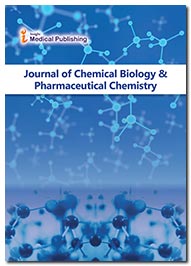ISSN : 2634-7814
Journal of Chemical Biology & Pharmaceutical Chemistry
Importance of Catalytic Asymmetric Synthesis of Saturated N-Heterocycles in Chemical Biology and Pharmaceutical Chemistry
Plato A Magriotis*
Department of Pharmacy, University of Patras, Greece
- *Corresponding Author:
- Plato A Magriotis
Department of Pharmacy
University of Patras, Greece
E-mail: pmagriotis@upatras.gr
Received date: September 15, 2017; Accepted date: October 06, 2017; Published date: November 10, 2017
Citation: Magriotis AP (2017) A Pictorial illustration of the inhibition of mycelial growth and spore germination of various sorghum fungal pathogens by a Bacillus species. J Chem Biol Pharm Chem 1:1.
Copyright: © 2017 Magriotis AP. This is an open-access article distributed under the terms of the Creative Commons Attribution License, which permits unrestricted use, distribution, and reproduction in any medium, provided the original author and source are credited.
Editorial
The important requirement for approval of a new drug, in case it happens to be chiral, that both enantiomers of the drug be studied in detail [1], have focused the attention of synthetic organic and medicinal chemists on the development of new methods for catalytic asymmetric synthesis especially of relevant saturated N-heterocycles. Despite the success of chirally modified transition-metal catalysts in asymmetric synthesis, in the form of the Nobel Prize in Chemistry in 2001, the field of asymmetric organic synthesis has since then been dominated by organocatalysts due to their ability to catalyze a variety of fundamentally important transformations in medicinal chemistry and therefore chemical biology. One example is the Staudinger synthesis of β-lactams representing one class of saturated N-heterocycles and continuing to provide unique opportunities for the discovery of new derivatives with novel pharmacological profiles [2]. Specifically, β-lactams have recently been found to have potential as the basis for treatments for neurological disorders including amyotrophic lateral sclerosis (ALS), also known as Lou Gehrig’s disease [3]. Although significant progress has been made in asymmetric organocatalytic Staudinger synthesis of β-lactams since the inaugural and pioneering investigations by Lectka and coworkers around the turn of the century [4,5], the same did not hold true regarding the development of a novel Gilman-Speeter process for the catalytic enantioselective synthesis of β-lactams [6]. Efforts directed at this latter goal are ongoing in this Laboratory.
On the other hand, the piperazine ring, besides defining a major class of saturated N-heterocycles, has been classified as a priviledged structure in Medicinal Chemistry since it is more than frequently found in biologically active compounds including several marketed blockbuster drugs such as Glivec (Imatinib) and Viagra (Sildenafil) [7,8]. Actually, an analysis of all U.S. FDA approved small molecule drugs found that 21% contained saturated 6-membered N-heterocycles with an additional heteroatom (N, piperazines; O, morpholines; S, thiomorpholines) [9]. Indeed, 13 of the 200 best-selling small molecule drugs in 2012 contain a piperazine ring [10]. In the vast majority of these molecules, however, the piperazine ring is not substituted on any of its carbon atoms. Specifically, analysis of the piperazine substitution pattern reveals a luck of structural diversity, with almost every single drug in this category (83%) containing a substituent at both the N1 and N4-positions compared to only a few drugs having a substituent at any other position (C2, C3, C5, and C6) [4,5]. Significant chemical space that is closely related to that known to be biologically relevant, therefore, remains unexplored. In order to explore this chemical space, an efficient and enantioselective synthesis of C-substituted piperazines must be designed and developed [11,12]. Efforts toward the implementation of this particular target are also ongoing in this Laboratory. Since piperazine derivatives have been reported to elicit a broad spectrum of pharmacological activities including antidepressant, anticancer, antihelmentic, antibacterial, antifungal, antimycobacterial, antimalarial, antituberculant, anticonvulsant [7,8], and anti-AIDS [13]; one can easily comprehend that the sky will be the limit, as far as novel drug development is concerned, once this catalytic enantioselective process will be fully developed.
References
- Stinson SE (2000) Chiral Drugs. Chem Eng News 78: 55-78.
- Galletti P, Giacomini D (2011) Monocyclic Beta-Lactams: New Structures for New Biological Activities. Current Medicinal Chem 18: 4265-4283.
- Rothstein JD, Patel S, Regan MR, Haenggeli C, Huang YH, et al. (2005) Beta-Lactam antibiotics offer neuroprotection by increasing glutamate transporter expression. Nature 433: 73-77.
- Lectka T, Taggi AE, Hafez AM, Wack H, Young B, et al. (2000) Catalytic, Asymmetric Synthesis of Beta-Lactams. J Am Chem Soc 122: 7831-7832.
- Magriotis PA (2014) Progress in Asymmetric Organocatalytic Synthesis of Beta-Lactams. Eur J Org Chem 2014: 2647-2657.
- Magriotis PA (2001) Recent Progress in the Enantioselective Synthesis of Beta-Lactams: Development of the First Catalytic Approaches. Angew, Chem Int Ed 40: 4377-4379.
- Alam M, Shaquiquzzaman M, Verma G, Marella A, Akhter M, et al. (2015) Piperazine scaffold: A remarkable tool in generation of diverse pharmacological agents. Eur J Med Chem 102: 487-529.
- Ye Z, Gettys KE, Dai M (2016) Opportunities and Challenges for Direct C-H Functionalization of Piperazines. Beilstein J Org Chem 12: 702-715.
- Vitaku E, Smith DT, Njardarson J (2014) Analysis of the Structural Diversity, Substitution Patterns, and Frequency of Nitrogen Heterocycles among U.S. FDA Approved Pharmaceuticals. Med Chem 57: 10257-10274
- Nelson A, James T, MacLellan P, Burslem GM, Simpson I, et al. (2014) A modular lead-oriented synthesis of diverse piperazine, 1,4-diazepane and 1,5-diazocane scaffolds. Org Biomol Chem 12: 2584-2591.
- Gettys KE, Ye Z, Dai M (2017) Recent Advances in Piperazine Synthesis. Synthesis 49: 2589-2604.
- Vo CV, Luescher MU, Bode JW (2014) SnAP reagents for the one-step synthesis of medium-ring saturated N-heterocycles from aldehydes. Nat Chem 6: 310-314.
- Nathans R, Cao H, Sharova N, Ali A, Sharkey M, et al. (2008) Small-molecule inhibition of HIV-1 Vif. Nature Biotechnology 26: 1187-1192.
Open Access Journals
- Aquaculture & Veterinary Science
- Chemistry & Chemical Sciences
- Clinical Sciences
- Engineering
- General Science
- Genetics & Molecular Biology
- Health Care & Nursing
- Immunology & Microbiology
- Materials Science
- Mathematics & Physics
- Medical Sciences
- Neurology & Psychiatry
- Oncology & Cancer Science
- Pharmaceutical Sciences
